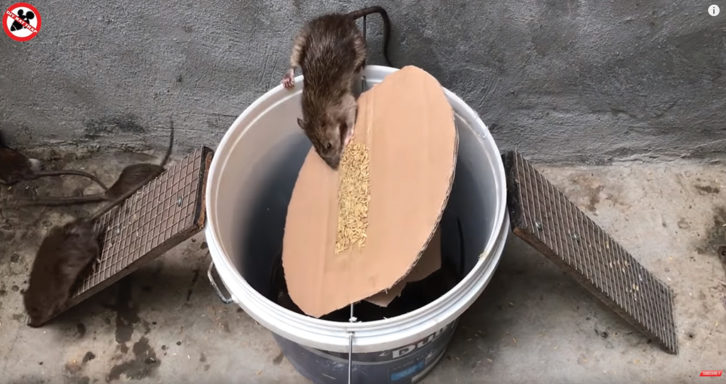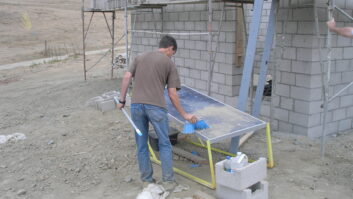Tom Johnson and I were talking about pests.

We met at the Alabama Broadcasters Association and Larry Wilkins’ Engineering Day seminar; and as we talked about bugs infesting transmitter sites, Tom shared the picture in Fig. 1.
I don’t know many engineers who care for wasps, hornets or other flying, stinging insects. Tom’s photo is a great reminder to spray under eaves, and around door and window frames — any place that’s protected from the weather.
Unfortunately, with cold weather approaching, it’s not just vermin that seek shelter from the cold. An unoccupied transmitter building or AM antenna tuning unit is an ideal home for insects and rodents. Make sure it is sealed.
ATUs in particular can attract unwanted guests. If your ATU has a light fixture inside, wait til it’s dark and then turn it on, then walk around the ATU looking for any escaping light (remember to look underneath, too; and also watch out for the “hot” tower). Any holes you spot, perhaps where bolts once held coils or other components, are “welcome signs” for insects, and usually the proper diameter for these insects to squeeze through. Plug those holes with RTV or caulk.
Remember also that before opening the ATU door, pause to watch whether stinging insects are flying around. They may have infested your enclosure already.
Check that entry panels or doors to the ATU also fit tight; again look for light leakage. Remember that field mice can squeeze through amazingly small crevices.
Tom waited till dark, then sprayed that nest and its occupants.
When I did contract work, a client was losing their satellite signal every day at dusk. I stood on a ladder and unscrewed the LNB. A swarm of angry wasps escaped the nest they built inside. How we didn’t get stung — or break a leg, frantically jumping off the ladder — still amazes me.
As I mention in my Workbench sessions, a one-liter clear plastic water bottle fits nicely in the throat of a satellite feed horn and will prevent infestation. As for your building, a good spritz of wasp and hornet spray applied under all the overhangs on your building is good preventive maintenance.
* * *
San Francisco contract and project engineer Bill Ruck writes, “Been there, done that.” He was referring to the electrolytic capacitor woes we described recently.
Back around 1967, Bill learned about electrolytic capacitors working at a hi-fi store. Rule of thumb in those days was (1) if they’ve “puked their guts” by exploding, replace them; (2) if not, replace them anyway.
Since then, Bill’s experience is only worse. Many times he has traced spurious outputs of an FM exciter to the power supply oscillating and modulating the carrier.
Recently, Bill had two BE FX-30 exciters with that problem. The issue was traced to the FMO module. The problem was that the FMO is potted and to dig out the potting compound to replace the capacitors would take a lot of time and was no longer cost-effective. The group owning the exciter preferred to purchase a new exciter rather than put a lot of money into reconditioning something that was over 30 years old.
Bill adds a few more nuggets to consider:
1. Although high ESR (equivalent series resistance) doesn’t cause “ringing,” it does let an unstable amplifier oscillate. Furthermore, most three-terminal regulators can be defined as an “unstable amplifier” and will oscillate. Bill learned in his own home-built power supplies to put a 1 uF tantalum bead capacitor and a 0.1 uF ceramic disc capacitor as close to the regulator IC input pins as possible.
2. Always put in 105 degree C electrolytic capacitors. They’re slightly larger and slightly more expensive but they last a lot longer.
3. It takes the same effort to remove capacitors from a printed circuit board to measure them, than to just replace them. Yes, Bill can measure ESR and capacitance, but he does that only to confirm his suspicions, after putting in new low ESR 105 C replacement capacitors.
In summary, Bill writes that these days, component level repair is less cost-effective than during his misguided youth; but if you do make these repairs, replace!
* * *

Our Workbench Malaysian connection, broadcast engineer Paul Sagi, found an interesting YouTube video that we’ll call “Curiosity Killed the Rat!” Here’s the link: https://m.youtube.com/watch?v=T-KJMM55A9A
Paul comments that it appears that clear box sealing tape was used to hold the grain, and the “ramps” appear to be floor tiles, placed so the underside faces up. Placing two ramps on opposing sides permit some rats to balance out each other, a single ramp may be better. Finally, for remote locations, Paul suggests affixing the ramp to the bucket, so it doesn’t fall.
My comment? I sure hope this isn’t someone’s transmitter site! That’s a lot of rats.
I also hope you’ll contribute to Workbench. You’ll help your fellow engineers and qualify for SBE recertification credit. Send Workbench tips and high-resolution photos to [email protected].
John Bisset has spent 50 years in the broadcasting industry and is still learning. He handles western U.S. radio sales for the Telos Alliance. He holds CPBE certification with the Society of Broadcast Engineers and is a past recipient of the SBE’s Educator of the Year Award.












